The Hermit in Lore: the Tarot
If images of the tarot represent powerful archetypes of the subconscious (a la Jung), then the hermit finds an appropriate place therein. The ninth card of the Major Arcana represents a universal stirring of feelings and emotions with respect to the world of society and human interaction.
In the popular mind, the hermit represents solitude and self-determination
in a positive sense, but also a misanthropic and anti-social attitude. The
tarot taps this paradox. The striking image commissioned for the Waite-Rider
set and the Waite publication of Pictorial History of the Tarot1 in
1909 succeeds ably in presenting the accoutrement of symbolism in the hermit.
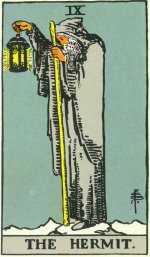
The hermit in Waite is not garbed like a beggar but like a friar, a Capuchin. Compare
the print of a Pauline monk (considered hermit garb) reproduced in Mary Rotha Clay's
work2.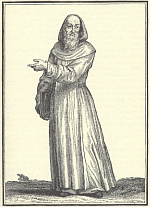 The Waite-Rider hermit is no wanderer but projects a mission with his
lantern and staff. Though Waite does not mention it, the lantern suggests
Diogenes the Cynic, the Greek precursor of the Western hermit, who searched
for a wise person among a world of fools. Not being a beggar, the hermit
does not represent isolation, idleness, or inability. His long white beard,
habit, and walking stick remind Waite of the Ancient of Days, while the
lantern is the Light of the World, shed for enlightenment of others. Hence,
he is not Diogenes the miscreant, the mischievous, the misanthrope. The
hermit is a sage, not simply searching for truth and justice but bringing
them to others. He stands at a precipice, like the Fool, but knows when to
stop. He is not, like the Fool, on a quest or adventure. He seeks to bring
light to others.
The Waite-Rider hermit is no wanderer but projects a mission with his
lantern and staff. Though Waite does not mention it, the lantern suggests
Diogenes the Cynic, the Greek precursor of the Western hermit, who searched
for a wise person among a world of fools. Not being a beggar, the hermit
does not represent isolation, idleness, or inability. His long white beard,
habit, and walking stick remind Waite of the Ancient of Days, while the
lantern is the Light of the World, shed for enlightenment of others. Hence,
he is not Diogenes the miscreant, the mischievous, the misanthrope. The
hermit is a sage, not simply searching for truth and justice but bringing
them to others. He stands at a precipice, like the Fool, but knows when to
stop. He is not, like the Fool, on a quest or adventure. He seeks to bring
light to others.
The mystery and motive of the solitary in Western history has always proven unsettling to the common person. The image of the hermit outside the context of daily life or subordination to authority has perplexed many. In Clay, we see glimpses of how some hermits were treated in medieval England and why anchorites were preferred by authorities. In the history of the Tarot, this antipathy is carried over; the hermit has represented negative values: circumspection, caution at best, dissimulation, roguery, and corruption at worse. Reversed, the card came to represent disguise, concealment, fear.
To which Waite replies that the negative characteristics are "artificial and arbitrary." He rehabilitates the hermit based on its universal archetype. Waite goes so far as to reject the concept of prudence assigned to the hermit by some, for this card is not mere temperance but enlightenment. The Hermit has attained enlightenment and now offers it to those who emulate his path.
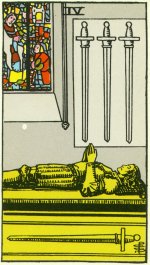 The other image in the Tarot associated with the path of solitude is the
Four of Swords, effectively rendered in Waite-Rider as a knight or effigy of
a knight lying on a tomb in an empty church. A stained glass window in the
background depicts a mother and child.
The image of the knight and swords projects finality, whether triumphant or
failed. The silence of the church is serenity or abandonment. But the image
of the Madonna and Child is so universal a portrait of nurture, protection,
and refuge, that the viewer concludes that the solitude of this card
represents continuity, rebirth, and transformation. The archetype affirms
the putting away of the vanities of the old self, of resting in
contemplation before marking the clean and innocent slate of a new life. The
Four of Swords signifies the need for all of us to experience the solitude
of the knight, and the embrace of the Universe.
The other image in the Tarot associated with the path of solitude is the
Four of Swords, effectively rendered in Waite-Rider as a knight or effigy of
a knight lying on a tomb in an empty church. A stained glass window in the
background depicts a mother and child.
The image of the knight and swords projects finality, whether triumphant or
failed. The silence of the church is serenity or abandonment. But the image
of the Madonna and Child is so universal a portrait of nurture, protection,
and refuge, that the viewer concludes that the solitude of this card
represents continuity, rebirth, and transformation. The archetype affirms
the putting away of the vanities of the old self, of resting in
contemplation before marking the clean and innocent slate of a new life. The
Four of Swords signifies the need for all of us to experience the solitude
of the knight, and the embrace of the Universe.
Additional representations of the Hermit
Here are some additional ideas and characteristics that the Hermit represents:
introspection, spiritual maturity, discipline or control, protection of the reservoir of wisdom versus dissipation of energy, active cultivation of sagacity, equilibrium between reality and wisdom and between authority and self-confidence, self-enrichment by all things that contribute to wisdom, prudence associated with silence and measure, love as the protection of universal balance, creativity as the life force preserving wisdom and harmony, ability to give as renunciation and as humaneness.
The Hermit in the Celtic Cross
In section 3.7 of Waite's book, the primary configuration of the cards, i.e., the spread, is introduced, though not as the Celtic Cross but as the "Celtic method of divination."
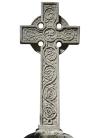 The cross itself carries a great weight of lore and meaning. As a
pre-Christian solar disc with universal directional points (that is, "sun
cross"), the Celtic cross was
an important astronomical and religious icon. As a Christian symbol, the Celtic
Druid symbols were enriched and extended. The cross bridges those cultures and
accommodates their symbologies well.
The cross itself carries a great weight of lore and meaning. As a
pre-Christian solar disc with universal directional points (that is, "sun
cross"), the Celtic cross was
an important astronomical and religious icon. As a Christian symbol, the Celtic
Druid symbols were enriched and extended. The cross bridges those cultures and
accommodates their symbologies well.
The Tarot presentation of the Celtic cross retains the traditional cross structure and adds a parallel column adjacent, which represents the upright that extends vertically and centrally from the uniformly-sized cross design encased in a circle.
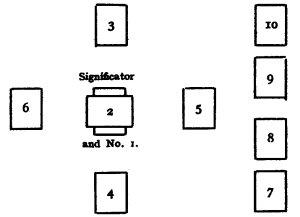
In pursuing a reading, cards placed into the ten loci have assigned meanings that take on the breadth of possible psychological elements pertinent to any given moment in a person's life. A certain card in a certain locus invites the questioner-inquirer-seeker to reflect upon the significance of certain factors in play at the moment. When assisted by an experienced drawer of cards and interpreter (i.e., diviner), the psychological interplay is heightened, somewhat like the dialogue of spiritual director, confessor or psychiatrist.
Waite presents the meaning of each of the ten loci very simply, beginning with a card he calls "significator" which is representative of the person who is the object of the reading. Waite would then proceed with the ten cards, the significator card becoming "lost" as an anchor is in port, buried into the subconscious. Each loci and card then represents:
- What covers him.
- What crosses him.
- What crowns him.
- What is beneath him.
- What is behind him.
- What is before him.
- Himself.
- His house.
- His hopes or fears.
- What will come.
But to choose a representative significator (especially for the inexperienced and for those performing the reading for themselves without an interpreter) is to anticipate too much of the entire process of thought, synchronicity, and outcome. Thus, this method is not recommended. Instead, the first card should be the significator, and the rest of the process continue as Waite describes it. There simply is no advantage in such circumstances to a significator as a kind of "zero" card.
Of the full 78 cards in the traditional Tarot, or even of the 24 cards in the Major Arcana, there are many possibilities, of course. The question here is: What is the meaning of the Hermit in any of the ten loci?
1. What he is.
This position represents the inquirer's personality. This is the defining
position in that it does not look to particular circumstances or attributes but
at the totality of the inquirer's persona. The essential psychological elements,
the entire situation and functional environment, how the person presents the
self -- all of these are contained in the first card.
The Hermit in 1. indicates the fundamental disposition of the personality without necessarily indicating that the inquirer has fully developed or fully embraced the Hermit. Much depends on the issue, problem, or question that the person has brought to the reading, so that the values of the Hermit may pertain only to the specific issue. The Hermit may belie the personality, may be too deep for credibility. Only the entire configuration of ten cards -- or a perceptive diviner -- will reveal this.
2. What crosses him.
This position represents the complement or contradiction to the first card. It confirms, modifies, or restates the presumed personality vis-à-vis the issue at hand. This card identifies the obstacles or influences on the personality. It imparts a realistic assessment to the presumptions of the questioner's personality.
The Hermit in 2. introduces a tempering effect to any personality. It modifies elements of power (Chariot, Emperor, Hierophant), clarifies elements of insightfulness (Sun, Fortitude), and gives a positive face to more radical archetypes indicating major change (Hanged Man, Wheel of Fortune, Death). Many people will welcome an element of discernment and calm insight to their busy personalities, and the Hermit as card 2 does this.
3. What crowns him.
It is important to note that other versions of the Celtic Cross configuration
place numbers 3 through 6 in different order, for example the 3 at the base and
proceeding clockwise (3 at 6 o'clock, 4 at 9 o'clock, etc.). Waite explained
the appropriate configuration briefly. At this point the inquirer could make the sign of the cross and see
traced the logical order of the next four cards from forehead (top) to abdomen
(bottom) and across from
left shoulder (3 o'clock) to right shoulder (9 o'clock). This is the most
inspired configuration for placing the
cards.
Card 3 represents the conscious ideals and goals of the person. This is not the person's value system -- always more complex and resting in the unconscious. Rather, the crown is the visible consciousness that stakes our perceived and perceivable possibilities and presents them as concrete (or hazy) configurations. At the unconscious level, these possibilities are visions and transfer realistic possibilities into unspecified aspirations at the conscious level, informed by moral contents. Thus card 3 addresses both the conscious and unconscious, but emphasizes the visible, i.e. the "crown."
The Hermit as crown represents the positive desire of the person to pursue the knowledge and techniques that bestow insight or understanding. The diviner will interpret whether this is mature or just a wishful desire. The Hermit in 3. might be reflective self-initiated ideals or a reflexive desire for a context, a teacher, or a regimen. In a mundane psychological sense, the Hermit as crown may only represent a skilled person's level of control and mastery in a profession, with a tendency not to share this knowledge or to reveal his or her feelings. This is either prudence or deception; that is for the diviner to discern. But there is an unconscious and spiritual element paralleling a quest for knowledge that accompanies the Hermit regardless of the person's unconscious disposition. The rest of the cards will tell.
4. What is beneath him.
Card 4 represents the past. It addresses foundational issues, that is, background, experiences, and causative factors in the questioner's past. The distant past and not the recent past is here addressed. Long-term factors that were formative influences for the questioner, involving attitude, temperament, and responses to the influences, are included. These issues of the distant past have since been reconciled, at least on the conscious level. Assessing their status on the conscious level is nevertheless still useful. No clear indication of their status on the subconscious level is intended by this card.
The Hermit as card 4 means that the person has experienced elements of introspection at one time in life but has lost that sense of collected self, for whatever reason to be interpreted from the other cards. Since few people would have likely experienced the Hermit in youth and renounced it -- or may have experienced it in a parallel context and now rejects the context and the Hermit because of its associations -- it is more likely that negative aspects may have predominated the past, either directly or indirectly. These elements include alienation, isolation, inhibition, psychological repression or depression. Or these negative aspects may have been more physical and literal: abandonment, lack of supervision or emotional warmth, manifested later in life in mistakes, failures, a false self, dishonesty, inability to function socially.
5. What is behind him.
This card is at the left pole of the cross and represents the context of the person's life. It may be said that the card represents more precisely the material or concrete context, referring to the totality of the person's environment: people, places, things. Those practical influences include personal relationships and interactions, the daily trajectory of living, including habits, routines, and objects used on a regular basis. There is an immediacy to the factor but not in a mental or psychological sense, only environmentally. Still, the inquirer is experiencing these factors as pressing factors, potentialities, trajectories, or pathways for self-definition and expression. They give boundaries to the anticipations of the inquirer, perhaps as something imminent.
The Hermit in this position would provide convincing elements for progress in the pursuit of enlightenment. An encouraging context might meet the expectation of the questioner. This position might be useful for the average seeker pursuing a more modest and circumscribed quest or resolution. A readiness of social factors implies that the questioner need only follow the archetype.
6. What is before him.
This position represents the state of mind formed by tangential circumstances in the present and the ongoing present which is the immediate future. This position completes the cycle of mental activity first represented in the crown but is more subtle in its dependence on circumstance. The inquirer will see them as factors in the immediate past, as recent factors, but this is essentially the immediate present and therefore the immediate future. The factors are not strong or dominant and can fade or wane as having only mundane relevance, but still they leave an impression.
The Hermit in 6. focuses the tangential factors into introspection. The questioner needs to search the very recent past, but this experience of the recent past has been deemed circumstantial and not relevant. Thus weak factors may be interpreted as irrelevant, but this is not necessarily so. Under the scrutiny of the Hermit, however, the status of these recent factors can be assessed. There is an absence or lack of integration -- either not enough interest on the part of the questioner, or simply a premature and shallow interest. If the Hermit is negative (context will show), then immaturity or skepticism is suggested. The cumulative wisdom of the traditional Hermit clearly requires a receptiveness based on maturity. It is likely that the Hermit in this position is calling for a more positive analysis of the recent past.
7. Himself.
Card 7 is the foundation of the pillar, the base of the upright, and therefore addresses the current status of the questioner. Hence Waite's terse description: "himself." The card in this position reveals the immediate mindset -- not the basic personality but the disposition to act and function as a projected person. There is a delicate dependence on circumstance and context in this projection of self onto the world, a "here and now" context that can be either serious or superficial. The card will hint at the surface, and card 10 will further interpret card 7.
The Hermit in 7 identifies a desire but not a grounding. Does the disposition of "himself" or "herself" mean that elements of a spiritual or psychological training and self-discipline are in place? The disposition may have been stimulated by a recent experience, so that desire for understanding and introspection is strong. But the experienced Hermit is built upon firmer factors represented in positions 3 through 6, and may require the questioner to honestly temper the self. The Hermit in 7 may refer, then, to the enthusiasm of encountering a teacher or influential person, reading a compelling book or essay, visiting a charmed place. The disposition of Hermit here is further complicated by the very nature of the question brought to the session. The questioner must guard against untimeliness or escapism. A willing disposition may yet be a seed sprouting from rocky or barren ground. Only other cards will tell.
8. His house.
This position further explore contextual issues. As mentioned, cards 3 through 6 address internal aspects of external context. Card 8 addresses external aspects of external context, hence, "the house." What is the inquirer's material circumstances and how do material circumstances affect the person? Responses to material circumstances obviously affect perceptions of reality and values. This position addresses routines of living, household, work, friends, and social circle. It overlaps with literal material circumstances: possessions, properties, design, taste, sensibilities. The inquirer functions in a material context but also reacts to it and receives feedback from it, a further elucidation of card 7. Card 8 establishes the totality of the inquirer's "interaction."
The Hermit in 8 defines aspects of the inquirer's daily circumstances, or at least attempts to identify the questioner's function within them. Someone already disposed to being solitary, a loner, alienated, anti-social, misanthropic, etc., will be included as much as the mature hermit, seeker, mystic, or fey soul. The daily circumstances are brought into sharp relief with the Hermit. Is the intellectual living as a rake, the solitary longing for a whirlwind of social engagements? Is a hyper-critical attitude masking alienation or past failure? Now is the time to glimpse the inner house's order. Also highlighted are material issues like finances, housekeeping, shoddiness, hygiene, schedule, consumption, a projection of superficiality or depth in daily life. If the diviner can see the inquirer's living arrangements, how much would be revealed!
9. His hopes or fears.
This position points beyond the context of conscious or subconscious to identify deep-seated sensibilities. The inquirer's subconscious instincts are probed with this position, passing through the material projections and arrangements to reach the heart of the personality. Repressed content, emotions ("hope or fear"), and deep-seated assumptions take the questioner past the public persona to the secret self, the core of the ego, the interiority of attitude and feelings.
The Hermit in 9 specifies the inquirer's true motivations in life. Or at least the true motivations with regard to the inquirer's question! A high-mindedness may be evidence of asceticism of the psyche and a desire to discipline the senses. Or the Hermit may reveal a cold-hearted and aloof manner, or a mask of rationality hiding a desire for acceptance. Again, the wisdom achieved by the Hermit may lack any social component. On the other hand, the trajectory may point to the watershed realization of futile engagement and worldliness nearly spent. The inquirer may fear this and rue it, or he or she may hope this is a revelation and embrace it. Again, the surrounding cards are the the ultimate factor, not a single card, even in the upright.
10. What will come.
At last, the questioner has reached an outcome that confirms, modifies, or cancels the "crown." This position does reflect expectations based on previous cards. It is a culmination or endpoint but of an outcome of a specific trajectory that began with a specific issue or question, not a universal application of the inquirer's total personality. That much said, the synchronicity of a rational outcome can be very persuasive. "What will come" is what will come given the inquirer's frame of mind and actions if the totality of the reading is rejected as much as if it is affirmed.
The outcome with Hermit in 10 may result positively in an affirmation of characteristics and values of the Hermit. The questioner will need to return to the personality of card 1 and its cross, card 2, to establish the nature of who is asking or pursuing, of who is interested in the question or issue. The questioner will need to return to the past (3 through 6) and present (76 through 9) to truly understand how the Hermit functions as a personality, an expression, a style of life, or an avocation. Presumably, the Hermit in 10 is calling for more than a short period of introspection or thoughtfulness about the inquiry. Rather, he Hermit in 10 proffers a mode of action, or, so to speak, inaction.
The Hermit is a set of values and skills. Just as an outcome of the Empress or King does not suggest that the questioner will become a monarch or other authority, neither does the Hermit in 10 mean literally that the person will now enter a solitary life. The totality of the reading, the honesty of the questioner, and the discernment of the diviner will all play a part.
¶
BIBLIOGRAPHICAL REFERENCES
- Waite, Arthur Edward. The Pictorial Key to the Tarot. Illustrations by Pamela Colman Smith. 1911; available on the Web at http://www.sacred-texts.com/tarot/pkt/.
- Clay, Rotha Mary. The Hermits and Anchorites of England. London, Methuen, 1914; reprints: Detroit, Singing Tree Press, 1968 and Fellowship of Solitaries (UK), 2000: http://www.solitaries.org.uk/page7.html (order info)